Abstract
One of the most important tasks of strategic management is modeling the development goal of the socio-economic system. The model must meet a number of requirements. Firstly, such a model will answer the question about the possibility of its achievement by the system. Secondly, with the help of the model, a strategy can be developed to achieve the target indicators and create the necessary resource for this. The article proposes an analytical model. The research result is presented in the form of graphic images - spatial - temporal diagrams. The spatial - temporal diagram is a set of points built on the Cartesian plane, the abscissa of each of which is time, and the ordinate is the state of the socio - economic system. Using these diagrams, you can get a model of the system’s management strategy, estimate the amount of resources needed to achieve the target indicators, and choose the optimal strategy from several strategies. A feature of the proposed method is that when modeling takes into account the stochastic nature of the influence of environmental factors. At the beginning of the article the main definitions related to goal setting are given. Then, the methodology for constructing spatio-temporal diagrams is briefly described. Using this technique, the primary goal is modeled. The primary target determines the numerical characteristics of the target. The influence of the lead time period on its size is discussed. Finally, the goal is adjusted taking into account the influence of environmental factors.
Keywords: Social and economic systemdevelopment goallocal target global goalmissionexternal environmentspatio-temporal diagrams
Introduction
An important step in the development of an organization’s management strategy is to develop a goal. Only correctly and correctly formulated goal allows you to build an optimal management strategy. A correctly set goal reduces the costs of its achievement, reduces the time to achieve it. On the contrary, the incorrectly designated goal of the development of the system does not allow one to choose the optimal one from the set of management strategies, increases the time to achieve it, and necessitates the use of an additional resource.
Therefore, it is very important at the stage of developing a strategy to obtain a model of the goal that would describe it adequately and accurately. The purpose of the article is to describe a methodology that allows you to get a graphical model of the goal, calculate its numerical characteristics. The importance of solving this problem has been repeatedly emphasized by leading economists ( Anand & Gray, 2017; Arend, Zhao, Song, & Im, 2017; Crilly, 2017; Maritan & Lee, 2017; McIntyre & Srinivasan, 2017; Wolf & Floyd, 2017).
Problem Statement
So, modeling of the development goal of the socio-economic system seems very important. It should adequately and accurately describe empirical data. In addition, the model should be not only descriptive. With its help, we must calculate the numerical characteristics associated with goal-setting.
Research Questions
We list the main objectives of the study. Firstly, it is necessary, using the proposed methodology, to build the goal of developing a socio-economic system. Secondly, using the model to calculate its numerical characteristics. Third, show how the external environment can adjust targets.
Purpose of the Study
The aim of the article is to build an analytical model of the development goal of the socio-economic system. The model should adequately and accurately describe the targets. The goal model should be quite simple, but at the same time, with its help, a number of numerical indicators related to goal setting could be calculated.
Research Methods
The article uses an original technique using spatial-temporal diagrams. By spatial-temporal diagrams we mean a set of points constructed in a Cartesian coordinate system. The abscissa of each such point is time, and the ordinate is the state of the system. State – an integral characteristic, which is a generalized characteristic of the internal environment of the socio-economic system. Such diagrams make it possible to build models for the development of socio-economic systems, evaluate resources, and choose the optimal system management strategy. The methodology of spatial design of spatial diagrams is described in more detail in the article ( Krylov, 2017).
Findings
Finding and setting a goal is called goal setting. Goals can be divided into local and global. Upon reaching a local goal, the system retains its composition and structure and is ready to achieve new targets. Having reached a local (intermediate) goal, the system sets new goals and develops the possibility of achieving it. If a global goal is achieved, then the system ceases to exist. The global goal is the result of the system. Achieving a global goal entails a radical change in the composition and structure up to its elimination. In some sources, the ultimate goal is also called vision. Goals can be considered, the achievement of which is possible only in an unattainable perspective, in the limit. They are called missions.
Realization of the final goal affects not only the system. The environment is also undergoing change. Environmental factors change, their influence weakens or amplifies. These changes should be taken into account in further analysis of the external environment. It is clear that over time, actions are reduced, leveled by the results of achieving goals by other systems. So, after the global goal is achieved, the socio-economic system forms a “footprint” that affects both environmental factors and other systems that fall into the zone of its influence.
Consider the factors that influence the choice of goal. First of all, these are the capabilities of the system itself, the state of its internal environment. Obviously, if the system does not have enough internal reserves, then it cannot achieve the goal. An important factor in goal setting is the ability of the system to obtain an additional resource from the external environment. Here it is necessary to accurately simulate the goal, since an external resource is allocated to the system only for a while and it will have to be returned. It may well be that the system is not able to return the borrowed resource necessary to achieve the goal. So, the goal should be modeled taking into account internal and external resources.
In a situation was considered when sections (zones) arise in the external environment, passage through which slows down the development of the system ( Krylov, 2017). In this case, irresistible sections (environmental factors) may arise that completely inhibit the development of the system. Obviously, the goal must be chosen so that there are no such irresistible areas. At least, the goal must be formed in such a way that it is achievable from the point of view of obstacles to environmental factors.
If the above factors are not taken into account, the system may be unattainable.
It can be assumed that the goal is a certain state, which the system seeks to achieve at a certain point in time. However, this assumption is erroneous. In the process of development of the system, a number of circumstances may arise, make an adjustment to the strategy. The process of system development is probabilistic, stochastic.
So, the goal is a set of T states of the systems, which it reaches at the moment of time. It would be wrong to say that the goal of developing a socio-economic system is a very definite state, which it seeks to achieve at a certain point in time. We emphasize once again that this is the final state. The interval in which the expected values of the target indicators are located is called the target orientation.
Accordingly, there is a time interval that determines the timing for achieving the goal.
What do the quantities and depend on? Firstly, the more clearly the target indicators are formulated, the more short the timeframe for its achievement will be, the denser, less “blurred” the goal will be. Secondly, the period of lead of the modeled target has a significant influence on and. The farther the target is from the moment of simulation, the wider the range of the target settings and the time interval will be. Finally, the external environment has a great influence on the goal. To take into account the influence of environmental factors (it is clear that this is a stochastic process, not a deterministic one), it is necessary to increase the interval of target orientations and the time interval.
We emphasize once again that the goal is only an assumed (in many ways - ideal) vision of the state of the system in the future. We turn to the model of the goal of the system. We carry out modeling using spatio-temporal diagrams. In this case, the state of the system s (the state is the integral characteristic of the internal environment of the system) at time t is modeled as a point with coordinates on the coordinate plane tOs.
The target is modeled as a closed T shape (Figure
Two lines of the first type limit the target in time. Line determines the minimum time to reach the goal. Accordingly, the line determines the maximum time for which the system reaches the goal.
Then the interval
determines the “extent” of the goal in time.
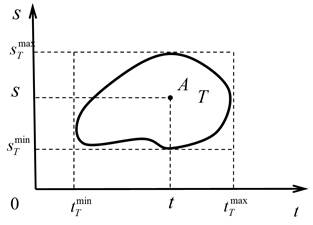
Similarly define the line
corresponding to the minimum states of the system, in which we can assume that the goal is achieved. Line
limits the target to the maximum value of the states. Similar to (
represents the possible state of the goal (targets).
The line bounding the target can be described using the function
The same function can be set implicitly:
Knowing the form of function (
Obviously, the area (
So, the main characteristics of the goal are: 1) time interval (
Consider Figure
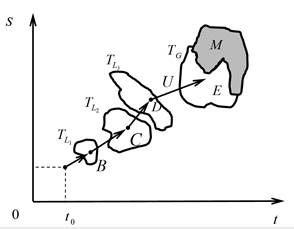
We proceed to the construction of a target model taking into account the influence of environmental factors
and
(figure
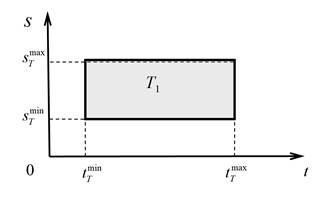
After that, we examine the external environment. As already noted above, there are areas (zones) of the external environment that are insurmountable for management. We distinguish such irresistible sections (Figure
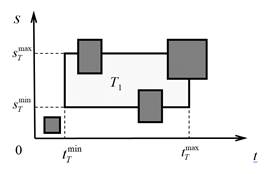
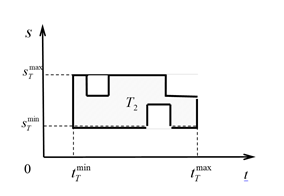
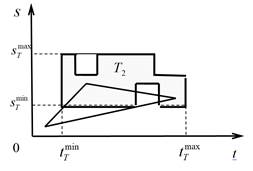
The general part of the figures F forms the target model T of the socioeconomic system (Figure
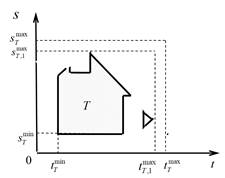
Conclusion
So, we got a model of the development goal of the organization. It takes into account both factors determining the internal environment of the organization, and environmental factors. Also, using the proposed model, it is possible to analyze the assessment of the resources necessary to achieve it. The model can be used to find a strategy for the development of socio - economic systems, calculate the planned indicators of the enterprise, determine the purpose (mission) of the organization. Taking into account environmental uncertainties makes the goal more accurate. Accordingly, a management strategy to achieve such a goal requires less resources.
References
- Anand, G., & Gray, J. V. (2017). Strategy and organization research in operations management. Journal of Operations Management, 53-56, 1-8. https://doi.org/10.1016/j.jom.2017.09.001
- Arend, R. J., Zhao, Y. L., Song, M., & Im, S. (2017). Strategic planning as a complex and enabling managerial tool. Strategic Management Journal, 38(8), 1741-1752. https://doi.org/10.1002/smj.2420
- Crilly, D. (2017). Time and space in strategy discourse: Implications for intertemporal choice. Strategic Management Journal, 38(12), 2370-2389. https://doi.org/10.1002/smj.2687
- Krylov, V. E. (2017). Dynamic model of the economic and social system control. In F.L. Gaol, N. Filimonova, F. Hutagalung (Eds.), Managing Service, Education and Knowledge Economic Era. London: CRC Press. Retrieved from: https://www.taylorfrancis.com/books/e/9781315269146/chapters/10.1201/9781315269146-10 Accessed: 18.11.2019.
- Maritan, C. A., & Lee, G. K. (2017). Bringing a resource and capability lens to resource allocation. Journal of Management, 43(8), 2609-2619. https://doi.org/10.1177/0149206317727585
- McIntyre, D. P., & Srinivasan, A. (2017). Networks, platforms, and strategy: Emerging views and next steps. Strategic Management Journal, 38(1), 141-160. https://doi.org/10.1002/smj.2596
- Wolf, C., & Floyd, S. W. (2017). Strategic planning research: Toward a theory-driven agenda. Journal of Management, 43(6), 1754-1788. https://doi.org/10.1177/0149206313478185
Copyright information

This work is licensed under a Creative Commons Attribution-NonCommercial-NoDerivatives 4.0 International License.
About this article
Publication Date
09 March 2020
Article Doi
eBook ISBN
978-1-80296-078-5
Publisher
European Publisher
Volume
79
Print ISBN (optional)
-
Edition Number
1st Edition
Pages
1-1576
Subjects
Business, business ethics, social responsibility, innovation, ethical issues, scientific developments, technological developments
Cite this article as:
Krylov*, V. E. (2020). Analytical Approach To Development Goal Modeling For The Socio-Economic System. In S. I. Ashmarina, & V. V. Mantulenko (Eds.), Global Challenges and Prospects of the Modern Economic Development, vol 79. European Proceedings of Social and Behavioural Sciences (pp. 1511-1518). European Publisher. https://doi.org/10.15405/epsbs.2020.03.217
